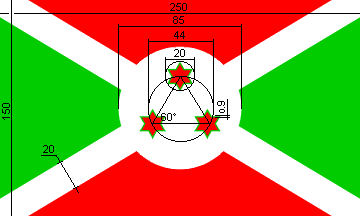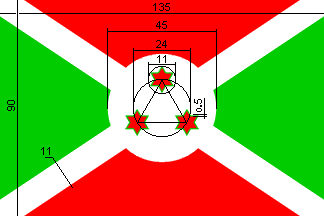
Last modified: 2011-08-20 by bruce berry
Keywords: burundi | construction sheet |
Links: FOTW homepage |
search |
disclaimer and copyright |
write us |
mirrors
 3:5.
Image by Željko Heimer, 22 January 2003
3:5.
Image by Željko Heimer, 22 January 2003A Presidential Decree Decret-loi No.1/31 dated 27 September 1983, Article One, contains
specifications for the flag as follows:
The national flag is 2.50m long x 1.50m wide:
- The arms of the saltire are 20cm wide
- The central disk has a diameter of 85cm
- The imaginary circles which contains the three stars have a diameter of 20cm
- The imaginary circle within which is inscribed an imaginary equilateral triangle placing the three stars has a diameter of 44cm
- Each star is carries a fimbriation 0.9cms wide.
The provision that the stars have six points is not carried over from the Decret-loi of 28 December 1968, but I think we may regard this as an oversight.
This flag in its original form was established by Royal Decree of 30 March 1962
(published in Official Bulletin No.8 of the Kingdom of Burundi dated 01 October 1962). However, a republic was proclaimed on 29 November 1966 and the flag modified by
No.1/72 dated 28 June 1967 (and again by Decret-loi No. 1/227 of 09 September 1968). The flag was then further revised by Decree 1/31 of 27 September 1982 and this provided the construction
specification given here. It was last confirmed in Title One, Article 8 of the Constitution dated 12 March 1992.
Christopher Southworth, 20 January 2003
Terrible numbers, I must say. Why not rather convert them to primal integers:
165 2475 170 2550 300 4500 88 1320 40 600 1,8 27They are still very uneven. Although stated in the law, these values must come from measuring of a ready flag design, instead of coming from the construction of that design. António Martins-Tuválkin, 22 January 2003
 2:3.
Image by Željko Heimer, 22 January 2003
2:3.
Image by Željko Heimer, 22 January 2003Decree 1/227 dated 26 December 1968 (Article 2) set the proportions
for the then flag at 2:3 (90 x 135cm)
with the central disk at 45cm, the arms of the saltire and stars at 11cm and the fimbriation at 5mm.
Quoting from the Decree: "The three stars are contained within three imaginary circles of
11cm diameter and form an imaginary equilateral triangle which is
contained within an imaginary circle of 24cm diameter whose centre is
that of the central disk. The base of the triangle is parallel to
the bottom of the flag."
Decree 1/73 of 28 June 1967 refers only to the original flag of 1962 and to no others, therefore
we may infer that the version without the drum symbol in use between 1966-7 was without sanction.
Christopher Southworth, 22 January 2003
Comparing the two flags, it is not easy to relate one to the other since the sizes are difficult to compare so I have created this table:
| 1982 | 1968 | |||||
| Length | 250 | 166,67 | 135 | 150,00 | ||
| Height | 150 | 100,00 | 90 | 100,00 | ||
| Disk diameter | 85 | 56,67 | 45 | 50,00 | ||
| "Circle" d. | 44 | 29,33 | 24 | 26,67 | ||
| Star diam. | 20 | 13,33 | 11 | 12,22 | ||
| Fimbriation | 0,9 | 0,60 | 0,5 | 0,56 | ||
I provide dimensions relative to the hoist given 100 units in second
column for each year. There are several conclusions one can draw from
it. First, the stars are always as big as the diagonals (so these are
not given in separate row above).
In 1982 the flag became longer, the disk was enlarged and the
diagonals got fatter, the stars follow. We may say that all elements
of the design are "highlighted" in the new design. I don't suppose
that further analysis of the dimensions have much meaning, but one
can notice that they are relatively similar. The imaginary "circle"
is ca. 10% bigger then double the width of diagonals. Also the star
diameter to fimbration width is approximately the same (ca. 22).
Željko Heimer, 24 January 2003
Unfortunately, the Royal Decree gives no indication of any construction details. The only reference comes in Article 2 where it states that
"A brown drum is (to be) placed in the white centre,
with a green ear of Sorghum in the same area as the drum".
Christopher Southworth, 22 January 2003